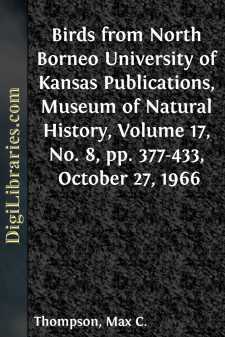Categories
- Antiques & Collectibles 13
- Architecture 36
- Art 48
- Bibles 22
- Biography & Autobiography 813
- Body, Mind & Spirit 142
- Business & Economics 28
- Children's Books 15
- Children's Fiction 12
- Computers 4
- Cooking 94
- Crafts & Hobbies 4
- Drama 346
- Education 46
- Family & Relationships 57
- Fiction 11828
- Games 19
- Gardening 17
- Health & Fitness 34
- History 1377
- House & Home 1
- Humor 147
- Juvenile Fiction 1873
- Juvenile Nonfiction 202
- Language Arts & Disciplines 88
- Law 16
- Literary Collections 686
- Literary Criticism 179
- Mathematics 13
- Medical 41
- Music 40
- Nature 179
- Non-Classifiable 1768
- Performing Arts 7
- Periodicals 1453
- Philosophy 64
- Photography 2
- Poetry 896
- Political Science 203
- Psychology 42
- Reference 154
- Religion 513
- Science 126
- Self-Help 84
- Social Science 81
- Sports & Recreation 34
- Study Aids 3
- Technology & Engineering 59
- Transportation 23
- Travel 463
- True Crime 29
Birds from North Borneo University of Kansas Publications, Museum of Natural History, Volume 17, No. 8, pp. 377-433, October 27, 1966
by: Max C. Thompson
Description:
Excerpt
ACKNOWLEDGMENTS
I am indebted to J. L. Gressitt of the Entomology Department of the Bishop Museum for providing the opportunity for me to work on the expedition and to examine and report on the material collected. Without the help of the North Borneo Department of Agriculture, the success of our expedition would have been restricted. The Entomologist of North Borneo, G. R. Conway, was of great help with our logistic problems as was the Director of the Department, Mr. E. J. H. Berwick, and the Agronomist of Cocoa Research Station, Ed Wyrley-Birch. The Bombay Burmah Trading Corporation, Ltd., provided facilities and transportation at Kalabakan. Mr. Dai Rees of that corporation should be especially mentioned. Others who helped are: J. A. Comber, Ronnie Young, Mr. and Mrs. Horace Traulsen, Maureen Wyrley-Birch, and the Resident, Tawau, Mr. Peter Edge. The Conservator of Forests kindly provided the necessary permits for collecting.
Authorities of the United States National Museum and The American Museum of Natural History generously permitted me to work at those institutions, using their specimens for comparative studies. Other specimens were borrowed from the Museum of Comparative Zoology, Rijksmuseum Van Natuurlijke Historie, British Museum (Natural History), and the Yale Peabody Museum. Dr. Alexander Wetmore, Herbert Deignan, and Charles Vaurie helped with some of the more difficult taxonomic problems. Specimens cited in this report are in the Bernice P. Bishop Museum, The University of Kansas Museum of Natural History, The University of Michigan Museum of Zoology, and the U. S. National Museum.
Richard F. Johnston and Robert M. Mengel kindly read the manuscript and made many helpful suggestions. The latter re-read it and assisted with the editing.
The most recent comprehensive work published previous to my preparation of manuscript for the present account was Smythies (1960) "The Birds of Borneo."
This report is a partial result of field work supported by a grant from the United States Army Medical Research and Development Command, Department of the Army, to the Bernice P. Bishop Museum for research on ectoparasites of vertebrates. The contract numbers were DA-MD-49-193-62-G47 and G65. The Chapman Fund of The American Museum of Natural History met part of the cost of transporting, to and from the United States, specimens from North Borneo collected after I left there.
While collecting at Quoin Hill, we used only guns in taking birds. At an area 12 miles north of Kalabakan, we supplemented the guns with mist nets in the primary forest. This method was excellent for taking rarely seen species. For example the thrush Zoothera interpres was never seen in the field but was taken several times in mist nets.
Another method of collecting was the use of native snares. Such snares were made of heavy nylon string tied to a sapling, held down by a nylon string attached to a treadle. When a bird stepped on the treadle, it tripped the snare and a loop closed about its feet, hoisting it aloft. To divert large ground birds and mammals into the snare, natives placed brush barriers along the top of a ridge for one or two miles. Animals were diverted by these barriers until they came to an opening; if they went through they usually tripped the trap. Pheasants and the large ground cuckoo were taken in this manner.
NOTES ON ZOOGEOGRAPHY
The avifauna of Borneo is of Indo-Malayan affinities. The number of birds endemic to Borneo is relatively small; most species are shared with the Asian mainland. Only 29 birds are known to be endemic to the island and 17 of these are montane. The large proportion of montane endemics is not surprising, because Borneo has been connected with the Asian continent in recent geological time; lowland isolation, and differentiation, has been less extensive than the montane....


